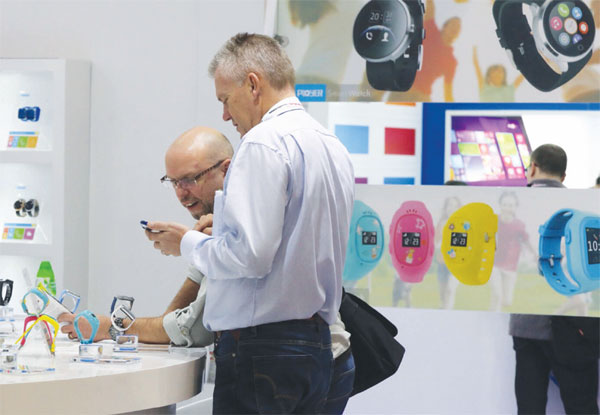Beating the copycat label - innovation's the answer
Updated: 2015-10-21 07:37
By Deng Yanzi in Hong Kong(HK Edition)
|
|||||||
|
Visitors appreciate smartwatches at the 2015 Global Sources Electronics Show in AsiaWorld-Expo. Photo provided to China Daily |
From robots that make you coffee to milk bottles that track your baby's drinking habits, walking across the cavernous halls at AsiaWorld-Expo during the 2015 Global Sources Electronics Show is quite an overwhelming experience.
Packed with some 5,800 booths by suppliers from Hong Kong, the Chinese mainland, South Korea and throughout Asia, the 2015 Global Sources Electronics Show, the world's largest electronics sourcing show, featured a rich array of electronic products.
The first phase ran from Oct 11-14, focusing on home, office and auto electronics, plus security products and electronic components.
The second phase, Global Sources Electronics Show, was held from Sunday to Wednesday, featuring the latest smartphones, tablets, wearables, accessories and drones.
Buyers could get insights into the rapidly accelerating innovation through various experience zones and the new Startup Launchpad Pavilion dedicated to "makers".
It would definitely be considered a successful trade show with the crowd it draws and the amount of deals it brings to the exhibitors and buyers.
However, the exhibitors unveiled a challenge that China is facing as it strives to transform itself from a manufacturing powerhouse to an innovation engine.
On a long, wooden table on my right-hand side are a series of smartphones, tablets and smart watches that come in black, white, and gold. They look and work almost the same as the smartphones, tablets and smart watches that come in black, white, and gold from another booth down the aisle.
In the drone area, you can spot a rip-off of Phantom 3, one of top drone maker DJI's latest products. The seller pulled out a piece of paper with specification of his drone and DJI, showing that while looking exactly the same, his drone even had better specs in battery and weight.
Some companies rush to label themselves "innovative" as soon as they jump on the bandwagon called "the next big thing" although they're actually making the next same thing.
Perhaps, it's too much to ask for a startup company or a maker to be the biggest innovator in a highly crowded market. Even Samsung has been mocked by critics for starting to make iPhone lookalikes.
And innovation is not just the remedy for Chinese mainland companies to get rid of the notorious "copycat" label, but also essential to their survival.
In 2010, after the success of Groupon, the number of the mainland's group-buying sites exceeded 5,000, but only 5.3 percent of them survived the battle as of 2014, as reported by news site China Economy.
Industry insiders warn that smaller players should be well aware of the risks of lacking creativity and a point of differentiation, as they can be easily wiped out once a major player enters the lucrative, homogeneous space.
Xiaomi, for instance, took over as the leader for wristbands in the mainland market within its first year of entry, squeezing out hundreds of Chinese wristband companies that have been riding on the wave of wearables in recent years.
Chinese tech guru Lee Kai-Fu warned makers against joining the bandwagon at a forum in July, pointing out that startups could never compete with the giants with the production capacity, the supply chain and the brand.
"If everyone is talking about it, and some big players are already in the market, startups will be at a huge disadvantage. The chances are very slim for small players," he said. "Pick another field."
Global Sources is a valuable platform that amasses the latest progress in technology and innovation each year from China, and next year, exhibitors should be encouraged to bring more truly innovative, out-of-the-box products here to show the world.
iris@chinadailyhk.com
(HK Edition 10/21/2015 page16)
